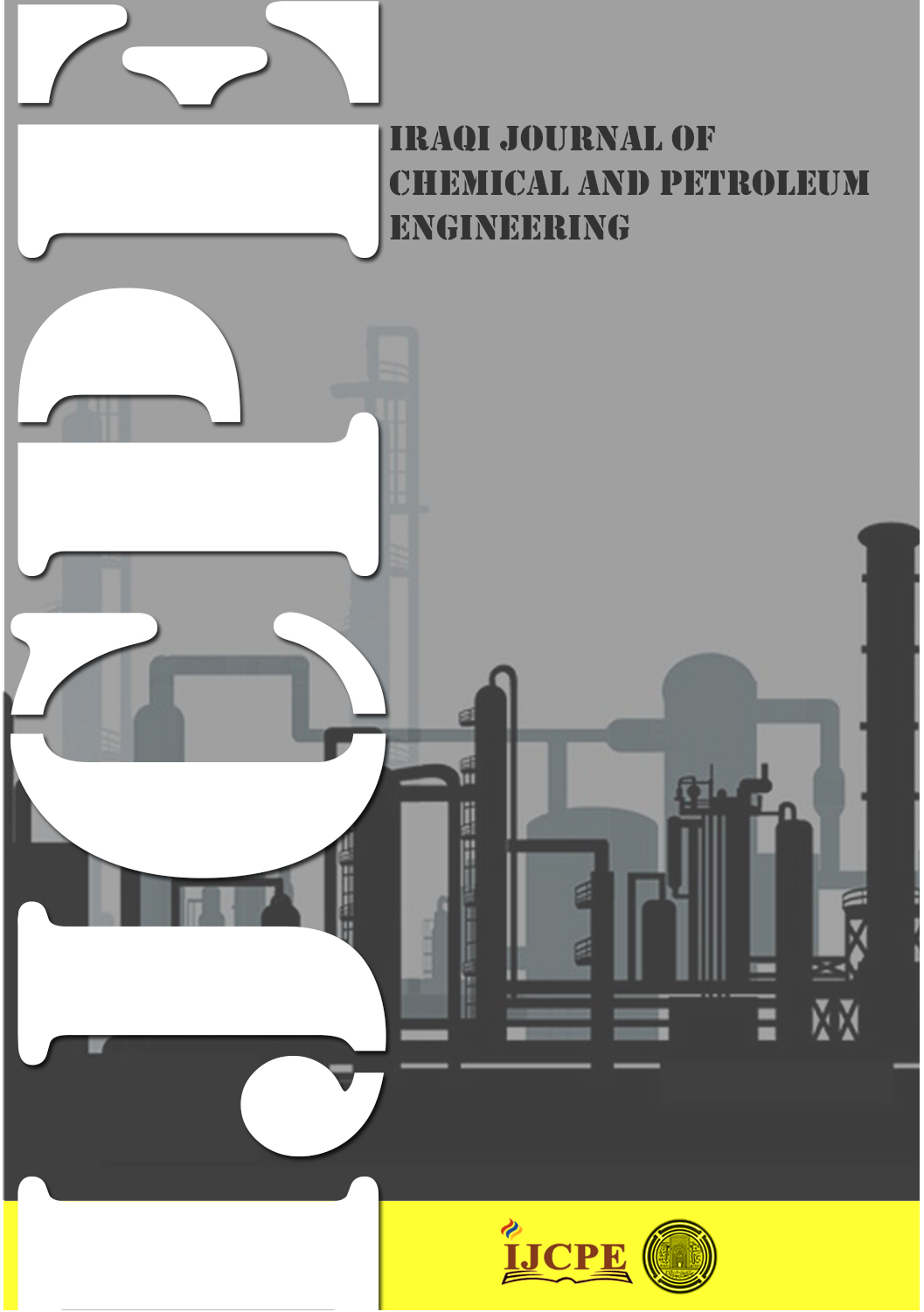Adsorptive desulfurization of benzothiophene from simulated fuel using Ni/ Γ-Al₂O₃ as an adsorbent; performance, adsorption, and kinetic study
DOI:
https://doi.org/10.31699/IJCPE.2025.1.9Keywords:
Gamma alumina oxide; ion exchange; Adsorptive Desulfurization; Adsorption isotherms models; kinetic modelsAbstract
Adsorptive desulfurization is essential for supplying clean fuel, reducing environmental pollution, and obtaining strict regulatory standards. This study focused on the adsorptive desulfurization of benzothiophene from simulated fuel using Ni/ γ-Al₂O₃ as an adsorbent. The study investigated the effect of nickel ions loading percentage on the removal efficiency. Also, the most fitted kinetic and isotherm models for the process were indicated. The modified adsorbent was characterized by different techniques, including XRD, FESEM, and EDS. The measurements revealed a successful modification of Ni/ γ-Al₂O₃, achieving the required loading percentages (2-10%). The desulfurization investigation was carried out under varying conditions of adsorbent dose (0.2-1 g), Ni loading percentage (2-10%), initial sulfur level of 100-260 ppm, and contact time (15-600 min). The results showed that Ultra-deep desulfurization was accomplished, with 96% sulfur removed from the initial concentration of 100 ppm at 1 g of adsorbent under room temperature and atmospheric pressure, 10% Ni ions content, and 600 min of contact time, and the highest adsorption capacity was 57.2 mg S/ g adsorbent at 260 ppm. The Langmuir isotherm model best described the process with R² of 99.9%, while the pseudo-second-order kinetic model had R² of 99.99%.
Received on 05/04/2024
Received in Revised Form on 30/07/2024
Accepted on 30/07/2024
Published on 30/03/2025
References
[1] Q. A. Mahmood, B. A. Abdulmajeed, and R. Haldhar, “Oxidative Desulfurization of Simulated Diesel Fuel by Synthesized Tin Oxide Nano-Catalysts Support on Reduced Graphene Oxide,” Iraqi Journal of Chemical and Petroleum Engineering, vol. 24, no. 4, pp. 83–90, 2023, https://doi.org/10.31699/IJCPE.2023.4.8
[2] G. K. Jabaar, H. A. Al-jendeel, and Y. Ali, “Desulphurization of Simulated Oil Using SAPO-11 with CNT ’ s as Adsorbent : A Kinetic Study,” Iraqi Journal of Chemical and Petroleum Engineering, vol. 24, no. 3, pp. 69–77, 2023, https://doi.org/10.31699/IJCPE.2023.3.7
[3] R. Contreras et al., “Transformation of thiophene, benzothiophene and dibenzothiophene over Pt/HMFI, Pt/HMOR and Pt/HFAU: Effect of reactant molecular dimensions and zeolite pore diameter over catalyst activity,” Catalysis Today, vol. 130, no. 2–4, pp. 320–326, 2008, https://doi.org/10.1016/j.cattod.2007.10.007
[4] B. D. Radhi and W. T. Mohammed, “Novel nanocomposite adsorbent for desulfurization of 4,6-dimethyldibenzothiophene from model fuel,” Materials Today Proceedings, vol. 42, pp. 2880–2886, 2021, https://doi.org/10.1016/j.matpr.2020.12.738
[5] M. A. Betiha, A. M. Rabie, H. S. Ahmed, A. A. Abdelrahman, and M. F. El-Shahat, “Oxidative desulfurization using graphene and its composites for fuel containing thiophene and its derivatives: An update review,” Egyptian Journal of Petroleum, vol. 27, no. 4, pp. 715–730, 2018, https://doi.org/10.1016/j.ejpe.2017.10.006
[6] M. M. Yahya and H. Q. Hussein, “Adsorption Desulfurization Of Iraqi Heavy Naphtha Using Zeolite 13x,” Association of Arab Universities Journal of Engineering Sciences, vol. 26, no. 2, pp. 12–18, 2019, https://doi.org/10.33261/jaaru.2019.26.2.003
[7] B. A. Altabbakh, M. N. Abbas, H. M. Hussain, and S. K. Hussain, “Preparation of Supported Bimetallic Ce/Fe activated carbon for Desulfurization reaction,” Journal of Petroleum Research and Studies, vol. 12, no. 1, pp. 173–190, 2022, https://doi.org/10.52716/jprs.v12i1.597
[8] F. J. Méndez, O. E. Franco-López, X. Bokhimi, D. A. Solís-Casados, L. Escobar-Alarcón, and T. E. Klimova, “Dibenzothiophene hydrodesulfurization with NiMo and CoMo catalysts supported on niobium-modified MCM-41,” Applied Catalysis B: Environmental, vol. 219, pp. 479–491, 2017, https://doi.org/10.1016/j.apcatb.2017.07.079
[9] K. O. Blumberg, M. P. Walsh, and C. Pera, “Low-Sulfur Gasoline and Diesel: The Key to Lower Vehicle Emissions,” The international council on clean transportation, May, p. 66, 2003.
[10] H. J. Mousa and H. Q. Hussein, “Adsorptive Desulfurization of Iraqi Heavy Naphtha Using Different Metals over Nano Y Zeolite on Carbon Nanotube,” Iraqi Journal of Chemical and Petroleum Engineering, vol. 21, no. 1, pp. 23–31, 2020, https://doi.org/10.31699/IJCPE.2020.1.4
[11] B. Radhi and W. Mohammed, “TiO2 loading on activated carbon: preparation, characterization, desulfurization performance and isotherm of the adsorption of dibenzothiophene from model fuel,” Egyptian Journal of Chemistry, vol. 66, no7. 0, pp. 428 - 437, 2023, https://doi.org/10.21608/ejchem.2022.109702.5003
[12] A. H. M. S. Hussain and B. J. Tatarchuk, “Adsorptive desulfurization of jet and diesel fuels using Ag/TiO x-Al2O3 and Ag/TiOx-SiO2 adsorbents,” Fuel, vol. 107, pp. 465–473, 2013, https://doi.org/10.1016/j.fuel.2012.11.030
[13] N. Jawad and T. M. Naife, “Mathematical Modeling and Kinetics of Removing Metal Ions from Industrial Wastewater,” Iraqi Journal of Chemical and Petroleum Engineering, vol. 23, no. 4, pp. 59–69, 2022, https://doi.org/10.31699/IJCPE.2022.4.8
[14] L. He, Y. Ren, B. Yue, S. C. E. Tsang, and H. He, “Tuning metal–support interactions on ni/al2 o3 catalysts to improve catalytic activity and stability for dry reforming of methane,” Processes, vol. 9, no. 4, 2021, https://doi.org/10.3390/pr9040706
[15] F. Kanwal, A. Batool, M. Adnan, and S. Naseem, “The effect of molecular structure, band gap energy and morphology on the dc electrical conductivity of polyaniline/aluminium oxide composites,” Materials Research Innovations, vol. 19, April 2018, pp. 354–358, 2015, https://doi.org/10.1179/1432891715Z.0000000001688
[16] A. H. A. K. Mohammed, H. Q. Hussein, and M. S. Mohammed, “The Effect of Crystallization Time and Acid Type on the Synthesis of Nano-Gamma Alumina Using Double Hydrothermal Method,” Iraqi Journal of Chemical and Petroleum Engineering, vol. 18, no. 2, pp. 1–11, 2017, https://doi.org/10.31699/IJCPE.2017.2.1
[17] K. K. Sarda, A. Bhandari, K. K. Pant, and S. Jain, “Deep desulfurization of diesel fuel by selective adsorption over Ni/Al 2O 3 and Ni/ZSM-5 extrudates,” Fuel, vol. 93, pp. 86–91, 2012, https://doi.org/10.1016/j.fuel.2011.10.020
[18] T. A. Saleh, K. O. Sulaiman, S. A. AL-Hammadi, H. Dafalla, and G. I. Danmaliki, “Adsorptive desulfurization of thiophene, benzothiophene and dibenzothiophene over activated carbon manganese oxide nanocomposite: with column system evaluation,” Journal of Cleaner Production, vol. 154, pp. 401–412, 2017, https://doi.org/10.1016/j.jclepro.2017.03.169
[19] S. K. Thaligari, V. C. Srivastava, and B. Prasad, “Adsorptive desulfurization by zinc-impregnated activated carbon: characterization, kinetics, isotherms, and thermodynamic modeling,” Clean Technologies and Environmental Policy, vol. 18, no. 4, pp. 1021–1030, 2016, https://doi.org/10.1007/s10098-015-1090-y
[20] X.F.Zhang, Z. Wang , Y. Feng , Y.Zhong , J. Liao, Y. Wang , J. Yao., “Adsorptive desulfurization from the model fuels by functionalized UiO-66(Zr),” Fuel, vol. 234, no. July, pp. 256–262, 2018, https://doi.org/10.1016/j.fuel.2018.07.035
[21] N. Gaur, K. Narasimhulu, and Y. PydiSetty, “Recent advances in the bio-remediation of persistent organic pollutants and its effect on environment,” Journal of Cleaner Production, vol. 198, pp. 1602–1631, 2018, https://doi.org/10.1016/j.jclepro.2018.07.076
[22] Z. N. Jamka and W. T. Mohammed, “Assessment of the Feasibility of Modified Chitosan Beads for the Adsorption of Nitrate from an Aqueous Solution,” Journal of Ecological Engineering, vol. 24, no. 2, pp. 265–278, 2023, http://dx.doi.org/10.12911/22998993/156886
[23] S. M. Al-Jubouri, H. A. Al-Jendeel, S. A. Rashid, and S. Al-Batty, “Green synthesis of porous carbon cross-linked Y zeolite nanocrystals material and its performance for adsorptive removal of a methyl violet dye from water,” Microporous and Mesoporous Materials, vol. 356, no. April, p. 112587, 2023, https://doi.org/10.1016/j.micromeso.2023.112587
[24] M. S. Abdulrahman, A. A. Alsarayreh, S. K. A. Barno, M. A. Abd Elkawi, and A. S. Abbas, “Activated carbon from sugarcane as an efficient adsorbent for phenol from petroleum refinery wastewater: Equilibrium, kinetic, and thermodynamic study,” Open Engineering, vol. 13, no. 1, 2023, https://doi.org/10.1515/eng-2022-0442
[25] T. Wang, M. Jiang, X. Yu, N. Niu, and L. Chen, “Application of lignin adsorbent in wastewater Treatment: A review,” Separation and Purification Technology, vol. 302, p. 122116, 2022, https://doi.org/10.1016/j.seppur.2022.122116
[26] T. R. Sahoo and B. Prelot, Adsorption processes for the removal of contaminants from wastewater: The perspective role of nanomaterials and nanotechnology. Elsevier Inc., 2020. https://doi.org/10.1016/B978-0-12-818489-9.00007-4
Downloads
Published
Issue
Section
License
Copyright (c) 2025 The Author(s). Published by College of Engineering, University of Baghdad.

This work is licensed under a Creative Commons Attribution 4.0 International License.













